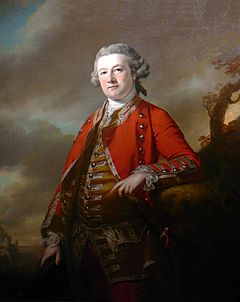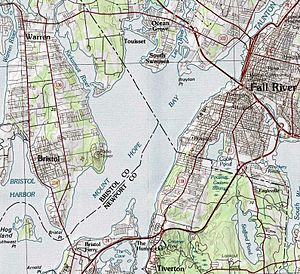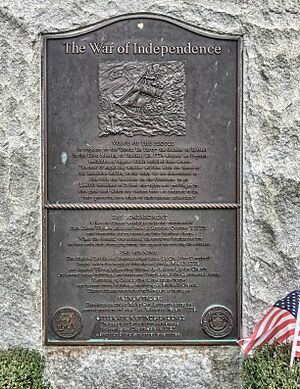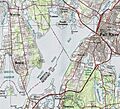Mount Hope Bay raids facts for kids
Quick facts for kids Mount Hope Bay raids |
|||||||
|---|---|---|---|---|---|---|---|
| Part of the American Revolutionary War | |||||||
 General Sir Robert Pigot (portrait by Francis Cotes), the organizer of the raids |
|||||||
|
|||||||
| Belligerents | |||||||
| Commanders and leaders | |||||||
| William Barton (May 25) Joseph Durfee (May 31) |
James Campbell (May 25) Edmund Eyre (May 31) |
||||||
| Strength | |||||||
| May 25: 500 regulars and volunteers May 31: 40 militia |
May 25: 500 regulars 2 frigates May 31: 100–150 regulars |
||||||
| Casualties and losses | |||||||
| May 25: 69 civilian prisoners taken May 31: 1 captured |
May 25: 11 wounded, 2 captured May 31, at Freetown: 2 killed, 5 wounded May 31, at Bristol Ferry: 2–3 killed, 1–2 wounded |
||||||
The Mount Hope Bay raids were attacks by British soldiers during the American Revolutionary War. These raids happened on May 25 and 31, 1778. They targeted towns along Mount Hope Bay in Rhode Island and Massachusetts.
The towns of Bristol and Warren, Rhode Island were badly damaged. Freetown, Massachusetts (now Fall River) was also attacked. However, its local defenders fought back better.
The British destroyed military defenses and supplies. These supplies were stored by the Continental Army for a planned attack on Newport, Rhode Island. Many homes, town buildings, and churches were also ruined.
On May 25, 500 British and Hessian soldiers landed. They were led by General Sir Robert Pigot. They destroyed boats and supplies, and took things from Bristol. Local resistance was small and did not stop them.
Six days later, 100 soldiers attacked Freetown. Less damage was done there. Local defenders stopped the British from crossing a key bridge.
Contents
Why the Raids Happened
The American Revolutionary War was a fight for independence. In December 1776, British forces took over Newport, Rhode Island. This was done without much fighting. Brigadier General Sir Robert Pigot became the commander there.
American forces wanted to take Newport back. Major General John Sullivan was put in charge of the Rhode Island defenses in March 1778. He started getting ready for an attack on Newport.
Sullivan stored equipment and supplies near Narragansett Bay and the Taunton River. General Pigot found out about these plans from a local supporter of the British. So, Pigot decided to launch a surprise attack.
On May 24, Pigot ordered 500 British and Hessian soldiers to move out. They were led by Lieutenant Colonel James Campbell. They crossed to the mainland in small boats.
Attacks on Warren and Bristol
Campbell's soldiers landed on Bristol Neck early on May 25. This was between Bristol and Warren. Campbell split his force into two groups. One group went to Warren, and the other went to the Kickamuit River.
The group at the river destroyed 58 small boats. These boats were meant for the American attack on Newport. They also burned a bridge and a sloop (a type of boat). Locals later put out the fire on the sloop, saving it.

The group in Warren expected a fight. But American soldiers, about 300 of them, had left the town. They heard the British force was much larger than it was. The British destroyed military supplies.
They also set fire to the town's powder magazine. The explosion destroyed six homes and the town's meeting house. They burned another sloop and five cannons. As they left, American resistance began to appear.
The two British groups rejoined and headed for Bristol. News of the British landing reached Providence. Colonel William Barton quickly gathered about 200 volunteers.
He rushed south and turned the retreating American forces around. They caught up with the British outside Warren. The two sides fought small battles as the British marched. Both sides had some injuries.
Colonel Barton was shot in the leg. This injury ended his military career, though he kept fighting that day. Campbell's men reached Bristol and caused a lot of damage. They destroyed 22 homes and a church.
They also took things from everywhere. One report said they "made no distinction between their Friends and Foes."
By noon, the British finished their work. They returned to their boats. British warships, including HMS Flora and HM galley Pigot, protected their departure. They sailed back to Newport.
This raid made General Sullivan ask for more help from local militias. But this help did not arrive before the next raid. The May 25 raids also included the capture of an American boat, the Spitfire. It was anchored near the Taunton River.
Freetown Attack
General Pigot then planned a smaller attack on lower Freetown. This area is now part of Fall River. On the night of May 30, 100 men left Aquidneck Island.
They were led by Major Edmund Eyre. Several naval ships, including HMS Flora and Pigot, went with them. The Pigot got stuck while passing through Bristol Ferry. But the other ships sailed up the Taunton River.
They landed near the Quequechan River in Freetown on Sunday morning, May 31. The local militia was led by Colonel Joseph Durfee. He was a veteran of the Continental Army. They had a lookout system.
A lookout spotted the British landing and raised the alarm. Forty men, from Freetown and nearby Tiverton, gathered to fight. Eyre's men fired a small cannon and slowly pushed the militia uphill.
Some of Eyre's men burned a house, a grist mill, and a sawmill. They also destroyed nine boats and 15,000 feet of wood planks. The militia reached a bridge across a stream. About 25 men set up a defense behind a stone wall.
For about 90 minutes, Durfee's men stopped the British from crossing the bridge. The British soldiers then took one local person prisoner. They set fire to his property and went back to their boats. The militia followed, shooting at them.
On their way back, the British ships tried to help the stuck Pigot. An American shore battery (a group of cannons) fired at them. The British had more injuries. The Pigot was also badly damaged.
The captured American, an elderly man named Richard Borden, was later released. In the Freetown battle, the British had two killed and five wounded. The Americans had no injuries, except for the captured man.
What Happened Next
The destruction of boats and supplies was a small problem for the Americans. In mid-July, General George Washington told Sullivan that a French fleet could help attack Newport. This made more people join the army.
Local shipbuilders quickly built new boats. By early August, the French fleet arrived near Newport. Sullivan had 10,000 soldiers ready. But bad weather and the arrival of a British fleet stopped the plans.
Sullivan had taken the northern part of Aquidneck Island. But many militia soldiers left when the French ships pulled away. General Pigot attacked Sullivan's forces. But Sullivan fought them off in the Battle of Rhode Island on August 29.
Sullivan then moved his troops off Aquidneck Island. The British stayed in Newport until October 1779. Then, their soldiers were moved to other places. The towns that were raided kept helping the American war effort.
Major Edmund Eyre, who led the Freetown raid, was later promoted. In 1781, he led British forces again. This was during a raid on New London and Groton, Connecticut. He was wounded early in the Battle of Groton Heights.
Images for kids
-
A 1984 USGS map showing Mount Hope Bay and the communities that were raided. Fall River was then part of Freetown.




